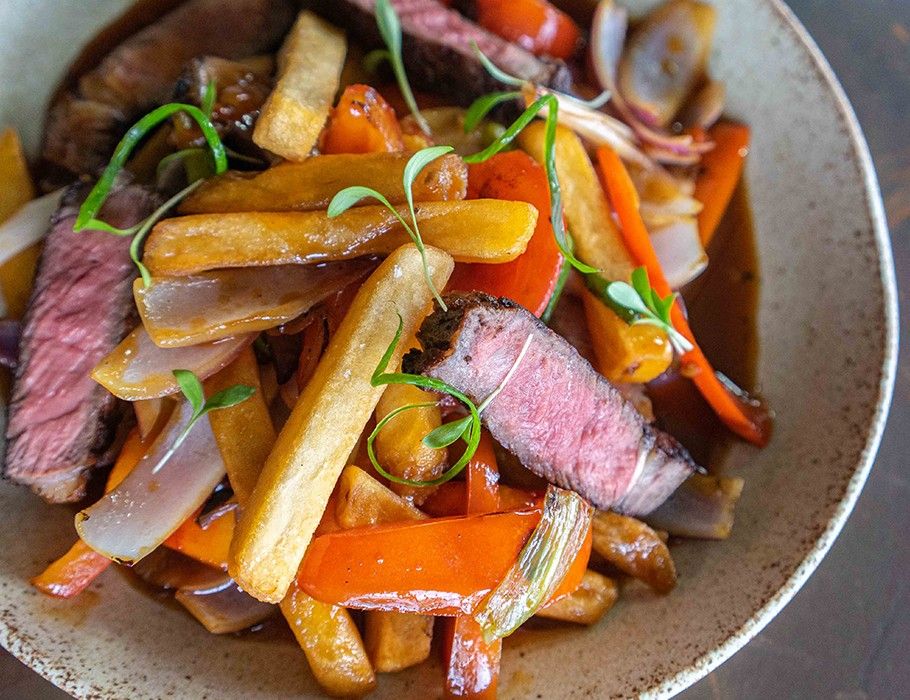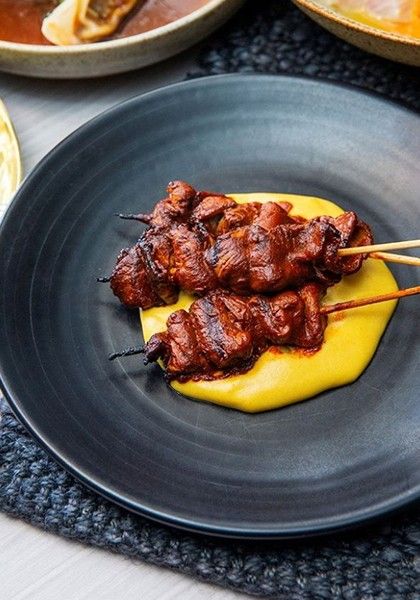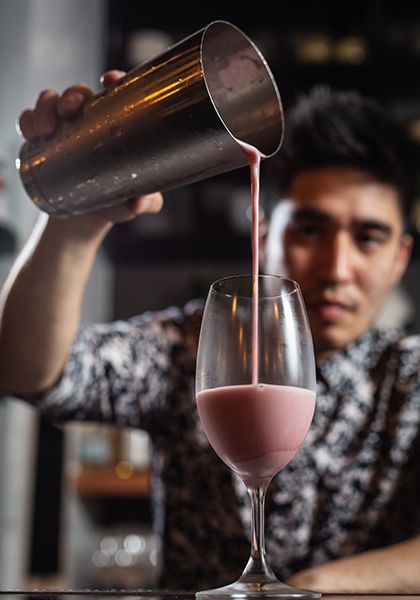

Melbourne Restaurants
Don’t call it Fusion: the Fascinating Migrant History of Peruvian Food
Words by Sofia Levin
Images by Sofia Levin, Bruno Stefani & supplied
Last updated 18.02.2022
Waves of migration have ingrained Chinese, Japanese and African cuisine into Peruvian food culture. This is a deep-dive into the history of Peruvian cuisine, worldly dishes and passionate people.
There's a lot to consider when defining Peruvian food. In Lima, tourists bite into cow’s heart skewers unaware they’re a street food born from African slavery. Local families visit restaurants on weekends specifically for Chinese fried rice. In the early 1900s, the Japanese blurred the line between ceviche and sashimi. All of these are traditional Peruvian dishes, but this is not fusion – it’s evolution.
Tracing the origins of Peruvian food is a culinary Robinson Crusoe adventure with only slightly less colonialism and far fewer religious references. Perhaps the best place to start is with potatoes. They were domesticated thousands of years ago in modern-day Peru, which now has an International Potato Centre that’s documented 4,000 varieties of edible ‘taters. Along with corn and chillies, potatoes are the cornerstones of the cuisine. When the Spanish took over from the Inca Empire in 1533, Peru’s ingredient repertoire broadened, and then continued to do so with the arrival of Chinese workers in the 1800s and Japanese immigrants at the turn of the following century.
Afro-Peruvian Slave Food to Street Food
The Spanish introduced rice, wheat and new sources of protein to Peru, and also ignited South America’s love affair with dulce de leche. They didn’t only ship over ingredients; they also brought African slaves. These slaves had to be resourceful, turning less-desirable ingredients into palatable food.
“The Spanish only ate the good quality meat, they gave all the insides to the slaves. They started putting spices and chillies, and now anticuchos (beef heart skewers) is one of the most famous street food you can find,” says Peruvian-born chef Luciano Vanini, co-owner of Harley House in Melbourne.
If you’ve been watching Netflix’s Street Food: Latin America, you would have also seen Picarones Mary, a Peruvian doughnut cart selling hot, syrupy picarones to people queuing in a park. These sweet potato and squash doughnuts are another creation of the African slave trade, who shaped dough into rings and tossed them in hot lard. Another of Luciano’s favourite Peruvian street foods is tacu tacu, a simple dish of rice and beans shaped into a pattie, that was once reserved for the poor.
“It’s everywhere and there are so many varieties, and that’s thanks to the Afro-Peruvians,” he says.

Chifa Peru’s Chinese-Influence Cuisine
When slavery was officially abolished in 1854, there was an influx of Chinese labourers between the 1850s and 1870s contracted to work on coastal plantations and in mines. Most were male, and many ended up partnering with Peruvian women. They brought ingredients like soy sauce and ginger and introduced cooking utensils fundamental in many Peruvian kitchens today, namely the wok. People with mixed Chinese and Peruvian heritage are referred to as Tusan, while Chinese-Peruvian restaurants are Chifa. According to Luciano, the word 'Chifa' was derived from 'chow fun' and is an integral part of Peruvian culture.
“Because they couldn’t say chow fun, they say, ‘Let’s go to the Chifa,’” he says. “You can find Chifa all over Peru, even in the small, tiny town you can find a Chifa – or at least a Peruvian fried rice.”
Peru's fried rice is called arroz chaufa and differs little to the original, but kalu wantan, braised pork or chicken in a tamarind and aji amarillo (Peruvian yellow chilli) sauce served with fried wontons, is a better example of how Chinese migrants incorporated local ingredients into Peruvian dishes. The most internationally iconic Chifa dish is lomo saltado, a Peruvian stir fry of beef sirloin strips and vegetables seasoned with soy sauce and served with both rice and fries.
“The flame of the wok and the fire makes it what it is,” says Luciano. “You can do it in a pan, but if you don’t have the wok it’s not lomo saltado, it’s called lomo al jugo.”
Without using the exact words, Luciano is referencing wok hei, the unmatchable charred aroma afforded to food cooked in a piping-hot wok.

At Citrico Cocina in the Melbourne suburb of Fitzroy North, owner Nan Kroll can’t bring herself to serve Aussies double carbs with lomo saltado.
“We’ve chosen to omit the rice from the dish because it is a bit too heavy with both. Your basic Aussies don’t know, but we do have Peruvian customers who are like, ‘Where is your rice?’” she says.
Head chef Daniel Salcedo has also created a take on Chinese-Peruvian fried chicken, where the drumettes are first cooked in master stock. At Citrico the dine-in menu even includes a glossary that explains the history of dishes like lomo saltado.
“It’s so varied because you have foodies who already know these things, but then you have people who are like, ‘Why are you serving a Chinese stir fry in a South American restaurant?’” says Nan.
Nikkei Peru’s Japanese-Influence Cuisine
In the late 1800s during the First Sino-Japanese War, there was a surplus of Japanese farmers looking for work. It coincided with the years following the Pacific War between Chile and Peru and Bolivia, which wiped out many of Peru’s Chinese workers. This led to Peru becoming the first South American country to welcome Japanese farmers. The first boat landed in 1899, and many never returned to Japan.
“When these communities started to grow, they wanted to have their own cuisine but couldn’t find certain ingredients,” explains Peruvian chef Alejandro Saravia from Pastuso, soon-to-open Farmer's Daughters in Melbourne and UMA in Perth. “For example, traditionally we don’t grow wasabi, so they replaced wasabi with Peruvian chillies.”
This resourcefulness with ingredients birthed the Japanese-Peruvian cuisine known as Nikkei. Another example of a Nikkei dish is tiradito, which is on the menu at Pastuso. Peruvian ceviche is served diced and turns white after being steeped in citrus. Tiradito on the other hand is sliced like sashimi and doused in a marinade just before serving, the acidity cooking the fish only slightly.



Tiradito is also on the menu at Nikkei Bar & Restaurant in Sydney, though this new-age version is made with duck breast. Venue manager Marco Oshiro Giron is used to people telling him that the menu is neither Japanese nor Peruvian.
“If people look at our menu they might say it’s not very Japanese, but Nikkei is not Japanese; it’s Peruvian food through and through, because it’s Japanese food made by Peruvians,” he says.
Nikkei opened in Sydney in November 2019, inspired in part by Marco’s heritage and in part by the desire to showcase a new take on an underrepresented cuisine.
“Growing up, the culture at home was very much South American and I still don’t know much about my heritage,” admits Marco. “You ask some fourth, fifth generations – they might not know very much about Japan, all they know is Peru.”
What Marco does know is his way around a bar. Not being tied to tradition enables him to create original Nikkei-inspired cocktails, like the Morada made with pisco (Peru’s national spirit), chicha morada (a drink made from purple corn), yuzu (Japanese citrus), aquafaba (chickpea water) and plum bitters.
“One of the biggest things we try to tell our customers is that Peruvian-Japanese is not fusion. Nikkei food is a cuisine that has 100 years of history. It’s an organic amalgamation of the cultures,” says Marco.



Defining Peruvian Food
Today Peru’s capital, Lima, is renowned for blending indigenous ingredients and recipes with modern techniques to create quintessential Peruvian dishes. Virgilio Martínez's Central Restaurante is perhaps best known for this, repeatedly appearing at the pointy end of The World’s 50 Best Restaurants list. With so many cultures intermingling over time, is it possible to define Peruvian cuisine? If you ask the pros, it comes down to the ingredients and the people who cook with them.
In Australia, native Peruvian ingredients are costly, which is why Alejandro imports three 40-foot shipping containers every year, each filled with the pride of Peru: chillies, pisco and wine.
“Here in Australia, a lot of key Asian ingredients are available in the market, so restaurants can source them with more cost-effective pricing and recreate the cuisine in an authentic way,” he says. “When I see restaurants that are claiming to do Peruvian food and not utilising Peruvian ingredients, I don’t think it’s fair.”
Luciano is more poetic about Peruvian food. “If you want to do something traditional, you need traditional people,” he says. “You don’t have that taste in your mouth, what your mum or your grandma use to cook, you don’t have the last thing that makes a dish amazing.”
But even if you can access the ingredients, befriend a Peruvian chef or order from a Peruvian restaurant, Luciano says that conquering the cuisine is impossible.
“You have this mix from all over the world. There are a lot of flavours you have never had in your life. In one life, you can not try all the dishes Peru has to offer.”
Join the Eat Curiously Movement
Subscribe to the food newsletter that goes deeper.
